Neil Clarke's Blog
August 25, 2025
Bulgacon
In early September, I will be a guest at this year’s Bulgacon, held in Pazardzhik, Bulgaria. I’ve never been to Bulgaria before, so I’m looking forward to visiting someplace new to me and meeting with local fans and fellow guests. I’ve just received my schedule:
Sept. 6 – 18:00–19:00 [EN] AI in Art and Why It Doesn’t Belong There – Neil Clarke
Sept. 7 – 15:00–16:00 [EN] Overview of the Speculative Fiction Magazines in the USA – Neil Clarke
Sept. 7 – 17:00–18:00 [EN] Bringing the Rich Culture of “Small Languages” into Publishing – A Talk with Neil Clarke, Francesco Verso and others – Moderator Nikolay Peev
Sept. 8 – 11:00–12:00 [EN] How to Publish Abroad: A Practical Advice – Elena Pavlova, Francesco Verso, Neil Clarke
August 2, 2025
Our wildlife pool
I shared this video of a Cooper’s Hawk enjoying the pool we set up for our wildlife on Bluesky and people wanted to know more about the setup.
https://neil-clarke.com/wp-content/uploads/2025/08/cooper-1.mp4We started doing this a couple of years ago. We live near a wildlife refuge and have lots of little and big friends dropping by. In addition to the variety of birds, we see a lot of chipmunks, squirrels, raccoons, foxes, opossums, and even the occasional bear and bobcat. It’s mostly for the smaller animals that aren’t eating one another. The Cooper’s Hawk was the first bird of prey we’ve seen in the pool, but there are many eagles, falcons, owls, and hawks in the area.
Our old fountain died and the new one attracted this hawk.
It has to be cleared out every few days, so I thought I’d take the opportunity to document how simple this setup is.
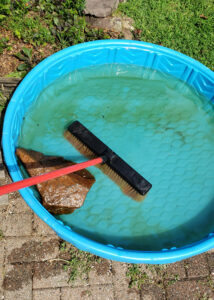
I started by cleaning out the algae with a large brush. I’ve found it easiest to leave some water and one of the bigger rocks in place for the first pass. Only takes a few minutes of brushing to clear it off the plastic kiddie pool that is the heart of this setup. I also use the brush on the rocks. After dumping the water, I hose everything down.
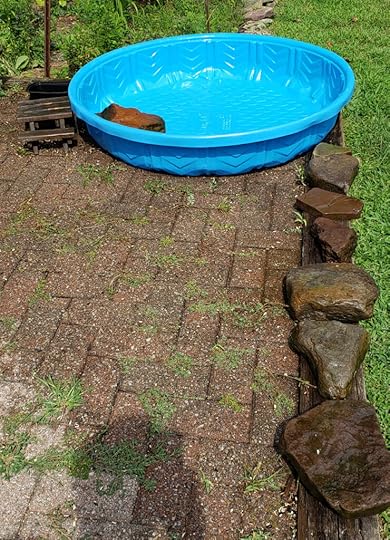
The rocks are used to create a variety of depths in the pool so the smaller animals can enjoy it and have something to help them climb out if they fall in. We also have a tiny picnic table that we leave fruit or nuts on for snacktime. A smaller plastic container is there for casual drinking. We’ve spotted some of the little birds (sparrows, junkos, etc.) using it for a bath.

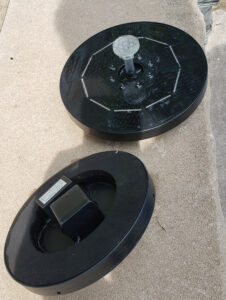
We also have a CEYOMUR Solar Trail Camera set up on the steps (facing the pool and picnic table) and an AISITIN solar powered water fountain. The one pictured at the top is the new one. The previous one (on the bottom) lasted two years before dying and then mysteriously started working again today when I went to toss it out. The fountains are under $20 and have survived rough play from the raccoons.

Since the second fountain started working again, I added more rocks and put it back. I like trapping the fountains to keep them from shooting water out of the pool. Learned that one the hard way.

And finally, a few snacks added to the picnic table and we’re all set for the next few days.
July 31, 2025
Seattle Worldcon Schedule
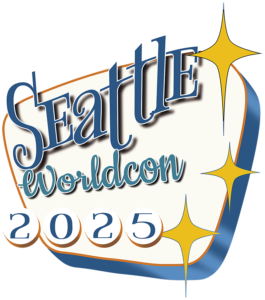
Later this month I’ll be attending the Seattle Worldcon. To help make it easier for people to find me there, I’m sharing my program schedule below. I do have some unofficial things scheduled (dinners, lunches), but otherwise, I’m happy to chat with people. If you can’t find me at the con, try to catch me after one of these events. If you need an icebreaker, ask for a rejection card (if I’ve rejected one of your stories at Clarkesworld) or the Worldcon exclusive Clarkesworld pin. You could even wish me a happy birthday (the 17th). Hope to see some of you there!
Wednesday August 13
Nothing Scheduled.
Thursday August 14
Short Fiction Editor Meetup
Terrace Lounge (4F), 1:30–2:30 p.m.
A chance for editors of short fiction, whether magazines or anthologies, to meet others in their field and make friends, swap ideas, and share information.
Autograph Session
Garden Lounge (3F), 4:30–5:30 p.m.
Friday, August 15
A Genre in Conversation With Itself
Terrace Suite (4F), 1:30–2:30 p.m.
There’s a joke about how every science fiction author writes either a Heinlein tribute novel, a story responding to The Ones Who Walk Away from Omelas, or a critique of Cold Equations. What makes science fiction so rife with response fiction? What sort of story inspires the need for authors to respond? What are some of our favorite examples of this trend?
Olav Rokne (M), John Scalzi, Becky Chambers, George R.R. Martin, Isabel J. Kim, Neil Clarke
Navigating AI as an Author or Editor
Room 431-432, 3–4 p.m.
From rights given away to words stolen, now that generative AI is out of the bag, how do we navigate this new landscape? How does the editor know if the work was AI-written? Are there any ethical ways of using AI as a writer? Our panelists discuss this provocative subject.
Jason Sanford (M), Cassie Alexander, Dr. Corey Frazier, Emily M. Bender, Neil Clarke
Saturday August 16
Magazines in the Modern Age
Terrace Suite (4F), 10:30–11:30 a.m.
Short fiction magazines are a vibrant and crucial area of our field, showcasing new and veteran writers, bold fiction, and a broad range of authors, stories, themes, and ethea. For magazines seemingly always clinging to survival, the past year has brought new challenges in publishing, revenues, and even ownership, along with new voices and brilliant stories. Panelists will discuss how they see short fiction magazines in the current age and going forward.
Scott H. Andrews (M), Neil Clarke, Mur Lafferty, Lynn M. Thomas
Saturday Evening – Hugo Awards Reception & Ceremony
Sunday August 17
Table Talk
Room 427, 10:30–11:30 a.m.
Have an intimate discussion (up to six participants) with your favorite creators. Advance signup is required.
July 7, 2025
Alternate Universe Ads
Since I’ve been trying to learn more about marketing, I’ve been paying closer attention to ads for all sorts of products. One of the more amusing things I’ve noticed is that if you are willing to embrace a certain overconfident marketing mindset, pharmaceutical ads can just as easily be genre magazine ads. In some parody parallel universe, these people are working for us.
Let me demonstrate:










I’m not sure what I will do with all this new arcane knowledge, but it was good for a laugh. (If you can’t read the text on the alternates, click and it will open in a larger window.)
Side effects may include…
May 2, 2025
How “AI” submissions have changed our submissions process
This is older news, but I wanted to have something I could easily point people to that explains how our submissions process has changed since the arrival of generative “AI” models.
Up until March 2023, our submissions review process worked something like this:
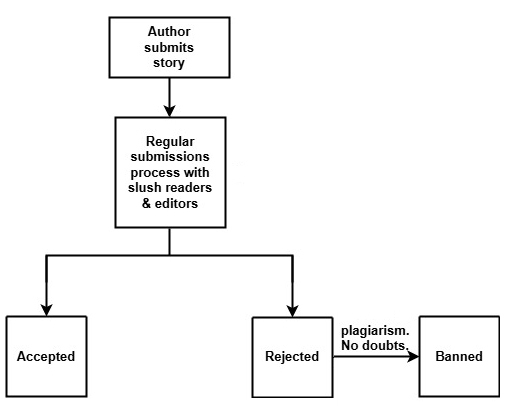
Plagiarism cases happened, but represented a very small percentage of monthly submissions. They were typically caught because:
Someone on our team recognized the workThey used a plagiarism detection evasion tool and it drew my attention (seen one, seen them all)We knew about the person from a whisper networkWithin months of ChatGPT’s public release, the signal-to-noise ratio shifted. Plagiarism was a fringe case and easily handled by the old model, but the sheer volume of generated work threatened to make human-written works the minority. The old way of finding the works we wanted to publish was no longer sustainable for us, so we temporarily closed submissions in February 2023.
When we reopened in March 2023, we implemented a new process that looks more like this:

The oval step is an in-house automated check. I haven’t spoken much about what we’re checking for there because I don’t want to make it easier for the spammers/sloppers to avoid being caught. Just like with malware and email spam, the patterns shift over time, so I’ve had to make regular changes within that oval over the last two years. (I am the developer of the submission software, so the responsibility for this falls to me.)
No process is perfect. Spam detection has existed for email for decades and still makes mistakes. I would never trust an algorithm to make a final assessment and fully accept that each “suspicious” story is a potential false positive. As such, I personally evaluate each suspicious submission. Our slush readers do not have access to this queue.
Bans are only issued when I am certain a work is generated or plagiarized. If I’m only 99% convinced, I’ll just flag the author for continued review. (One of the few things I’ll admit is part of the oval.) These cases always end in rejection, but they never would have made it further in the submissions process anyway. Some of them likely were using AI, but I’d rather err on the side of caution when banning on the table.
If I believe a work was miscategorized, I check why (to see if I need to refine the filters) and move it back to the main queue. Some of these stories have resulted in acceptance and publication. According to my data, there’s no indication that false positives have negatively impacted our final evaluations. We don’t limit the number of stories we accept on a monthly basis, so there are no missed opportunities in the process. The worst that happens with a miscategorized work is a slightly longer response time. How long depends on whether or not there is an active surge in generated submissions. (Unlike 2023, the daily and weekly volume of generated submissions is more spikey. Some good days. Some really bad.) The range has been anything from a delay of hours to a couple of weeks.
The intent of the oval is not to save time, but rather to act as a pressure valve. What broke our process in 2023 was the signal-to-noise ratio. By redirecting the flow of suspicious submissions to a separate queue, we’ve been able to maintain our team’s attention on the work that has to happen on a daily basis. Adopting this approach has given us the ability to weather storms significantly worse than the one that shut us down and more importantly, it has done so without creating an undo burden or deterrent for authors.
Checking the suspicious submissions has, however, added a substantial amount of work to my plate over the last two years. I’ve begrudgingly accepted this price because of the value I assign to having an open submissions process. Having a path for new and lesser-known voices to find their way into our pages is very important to me and this has kept that door open.
The price I pay is directly impacted by the false positive rate. That’s an area for continued improvement and a topic for another day.
—
And repeated from the previous post: For those that would respond to our complaints with “why don’t you just judge it on its own merits”, keep dreaming. Despite the hype, even if we set aside our legal and ethical concerns with how these systems were developed, the output of these tools is nowhere near the standards we expect. Besides, we’ve said we don’t want it. We don’t publish mysteries or romance either, but those authors are at least respectful of our time and don’t insist that we evaluate their work “on its own merits” when it doesn’t meet our guidelines. (This is not to equate mystery or romance writers with people who use generative AI. Simply demonstrating how real writers behave.) Why would we want to work with someone that can’t respect that?
May 1, 2025
Google is still at it
For over a month now, Google has been spreading lies about us. The text below was created by their generative AI tools and inserted into the first page search results for various searches for “Clarkesworld” originating in the US. It’s even more likely to show up in date restricted (last 24 hours, last week, etc.) or “verbatim” responses. Numerous people have submitted complaints on our behalf, including some Google employees, but this result continues to display.

The problem is that last line. We’ve never published AI-generated stories. In fact, we’ve been extremely vocal about not wanting them. When a surge in generated submissions overwhelmed our submissions process and required us to temporarily close that door in 2023, it became a widely-covered story in media outlets around the world (NPR, BBC, Wired, New York Times, The Guardian, Washington Post, etc.). Not only was our position firmly established, I was also openly critical of OpenAI, Google, and the other players in this field.
Here’s what it says in our submission guidelines for writers:
Statement on the Use of “AI” writing tools such as ChatGPT
We will not consider any submissions translated, written, developed, or assisted by these tools. Attempting to submit these works may result in being banned from submitting works in the future.
And here’s a statement that authors must agree to when they submit a story to us:
[ ] I declare that I am the legal representative for this story; it was not created by or with the assistance of “AI” machine learning tools, such as ChatGPT, Jasper, etc.; it has not been previously published in English; and it is not under consideration by any other publishers.
I understand that misrepresenting facts about this story may result in being banned from further submissions and/or revocation of any protections established by the publisher’s confidentiality policy.
We also require the authors we publish to confirm that a story is not plagiarized or written with “AI” tools as part of their legally-binding contract with us.
Clearly, we don’t want generated stories and never have, so if you happen to be served up that “AI” summary while searching Google, do us a favor and click on the three dots next to “About Clarkesworld Magazine” and send them some feedback. It probably won’t accomplish anything, but screaming into the void offers some therapeutic value.
And once again, for the record, Clarkesworld does not publish “AI-generated stories.” All our stories are written by human beings without the assistance or use of generative AI. We have banned thousands of people who have tried to pass-off generated nonsense as their own work.
—
For those that would respond to our complaints with “why don’t you just judge it on its own merits”, keep dreaming. Despite the hype, even if we set aside our legal and ethical concerns with how these systems were developed, the output of these tools is nowhere near the standards we expect. Besides, we’ve said we don’t want it. We don’t publish mysteries or romance either, but those authors are at least respectful of our time and don’t insist that we evaluate their work “on its own merits” when it doesn’t meet our guidelines. (This is not to equate mystery or romance writers with people who use generative AI. Simply demonstrating how real writers behave.) Why would we want to work with someone that can’t respect that?
April 2, 2025
Why Clarkesworld isn’t in bookstore newsstands
When I started Clarkesworld in 2006, it was already pretty well established that the shortest path to bankruptcy for a magazine was newsstand distribution. Since that time, it’s only become worse as the number of distributors has decreased and the costs have skyrocketed.
Print magazine distribution is even more broken than bookstore distribution. When a bookstore returns a book, the publisher gets charged a restocking fee, but the book is back in inventory and can be sent out to another bookstore that wants it. When a magazine is returned, it is destroyed and neither the bookseller nor distributor are penalized. Losses are entirely in the hands of the publisher.
When you hear a magazine talking about “sell through” they are talking about the percentage of copies that are actually sold. Of the genre print magazines I’ve been tracking, sell through has ranged between 25 and 50%, meaning more than half of the copies printed and shipped to the distributor end up destroyed. Attempts to better optimize sell through by printing fewer copies don’t necessarily result in better sell through. Complicating matters further, smaller print runs often lead to higher per-unit costs. (The inverse is true as well. Bigger print runs tend to result in cheaper prices. There is an economy of scale that favors larger print runs and publishers with multiple titles.)
There’s also the expectation from booksellers that a new magazine will engage in promotional efforts, not just on the national stage, but in their stores as well. This, combined with the necessary sample copies to market to bookstores, can require a more significant financial investment to establish a viable footprint.
Now let’s talk about bookstore magazine displays. Have you ever looked for one of the three SFF digests in a bookstore? You have to know what you are looking for because more often than not, you can only see the top inch or two of the cover. This renders cover art, one of the most effective in-person marketing tools, reasonably ineffective. Casual discovery is far less likely than it is with books. Interestingly, this problem could be addressed by shelving the magazines with the genre books, but that is against the standard behavior of nearly every bookstore on the planet. Magazines go here. Books go there. Visibility is extremely limited. The existing genre magazines in that ecosystem established their presence there before these limitations became as big as they are today.
Now, supposing you’ve bitten the bullet and decided to invest in a print run large enough for national distribution, you have one more problem: how long it takes to get paid. Most printers expect to be paid within 30 days of your invoice, assuming you’ve convinced them to allow that. (If you don’t have sufficient credit, you may have to pay some or all of it up-front.) It may be months before you are paid, so you will be in the hole for one or more issues before you receive payment or know how you should be scaling your print runs.
It can take months to establish a viable newsstand presence and months represent significant numbers of dollars small publishers don’t normally have. It’s a huge gamble and frequently one that fails to pay off.
So why establish a newsstand presence at all?
Let’s hop back to books for a moment. When the print edition of a book is in stores, it is seen. This often leads to a bump in the sales of ebooks. You could almost considering a market expense, one that could possibly pay for itself.
Being on a newsstand is a kind of marketing. It’s being seen and regularly reminding readers you exist. If someone picks up a few issues at the newsstand, they are more likely to become a subscriber, which is where the real money in genre magazines exists. Thing is, before the Amazon fiasco, the leading genre print magazines were selling more digital than print subscriptions. The previously mentioned limited visibility has made it less effective than it once was. In fact, print subscriptions and newsstand sales have been declining in volume for well over a decade. Not only that, print subscriptions have higher overhead than digital subscriptions. It’s entirely possible to earn more from a digital subscription than a print one, even when the print subscription is significantly more expensive. (Thank printing and shipping costs for much of that.)
To take things very close to today, there has been a lot of talk about tariffs on Canadian goods. Guess where printers get most of the paper they use for books and magazines? You guessed it, Canada. Even if they don’t happen, paper costs will continue to rise, just not as sharply.
We’re a small publisher. Gambling on print distribution was always risky. Today, it would be a deathwish.
We’ve had a print edition for many years now and while it can be a headache sometimes, it’s not an anchor that will drag us down. People who really want it that way can get it. We could probably sell a lot more of them, but newsstand distribution would be a substantial drain on revenue, time, and other resources. The same effort put into expanding our digital distribution and subscriptions would likely yield far greater results for our bottom line without having to risk the entire operation. With limited time and resources, I don’t see any path to print newsstand distribution in our future. Simply put, the idea of having Clarkesworld on a newsstand is more nostalgic than practical.
February 11, 2025
2024 Clarkesworld Readers’ Poll Final Voting
Please check out the February Clarkesworld editorial for a list of this year’s Clarkesworld Readers’ Poll finalists in Short Story, Novelettes/Novellas, and Cover art.
Voting on the winners in each category will close on February 15th at 11PM EST and this year’s winners will be announced in my March editorial.
January 22, 2025
2024 Clarkesworld Readers’ Poll – Round One
Celebrate your favorite Clarkesworld stories and cover art by nominating them at:
https://www.surveymonkey.com/r/clarkesworld2024r1
POLL CLOSES FRIDAY, JANUARY 24th at 3PM EST
Finalists will be announced in the February editorial.
December 17, 2024
Clarkesworld’s 2024 Fiction
Here are the stories and cover art published in Clarkesworld Magazine’s 2024 issues (in order of appearance and classified by word count):
Short Stories
 ” by Resa Nelson“Mirror Stages” by Claire Jia-Wen“Luminous Glass, Vibrant Seeds” by D.A. Xiaolin Spires“Technicolor Bath” by Raahem Alvi“Unquiet Graves” by Michael Swanwick“Stranger Seas Than These” by L Chan“From Across Time” by Chisom Umeh“The Painted Skin and the Final Stroke” by Zhu Yixuan“Souljacker” by Shari Paul“Driver” by Sameem Siddiqui“The Coffee Machine” by Celia Corral-Vázquez, translated by Sue Burke“Life Sentence” by Gelian, translated by Blake Stone-Banks“Retirement Plan” by Paul Starkey
” by Resa Nelson“Mirror Stages” by Claire Jia-Wen“Luminous Glass, Vibrant Seeds” by D.A. Xiaolin Spires“Technicolor Bath” by Raahem Alvi“Unquiet Graves” by Michael Swanwick“Stranger Seas Than These” by L Chan“From Across Time” by Chisom Umeh“The Painted Skin and the Final Stroke” by Zhu Yixuan“Souljacker” by Shari Paul“Driver” by Sameem Siddiqui“The Coffee Machine” by Celia Corral-Vázquez, translated by Sue Burke“Life Sentence” by Gelian, translated by Blake Stone-Banks“Retirement Plan” by Paul Starkey
Novelettes
Novellas




